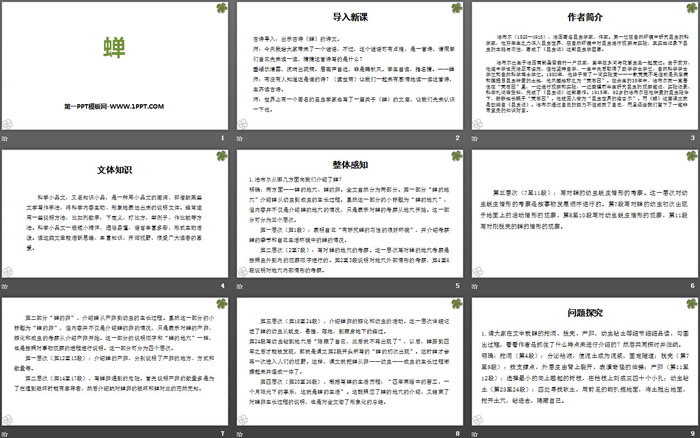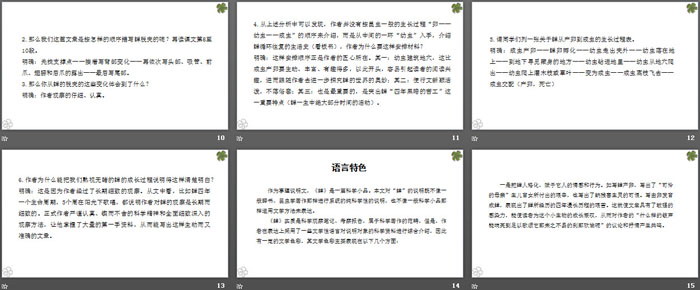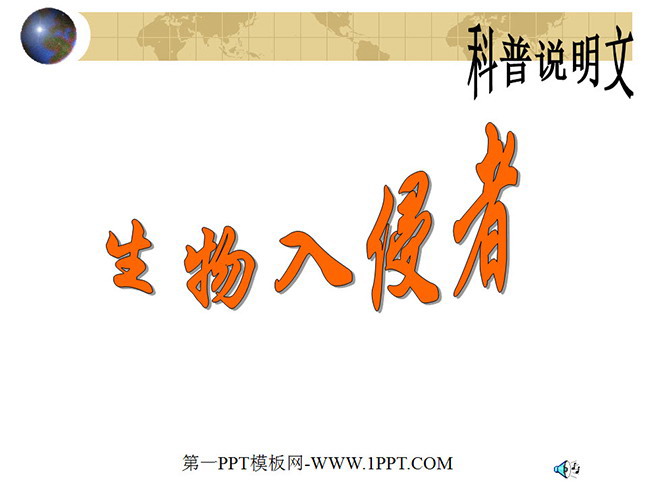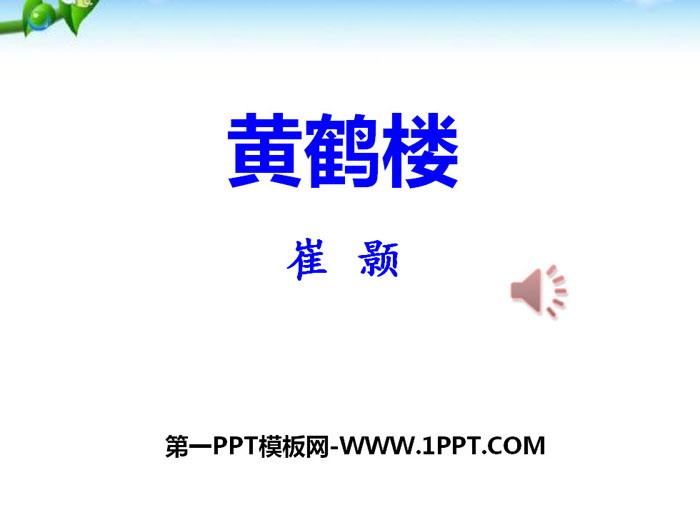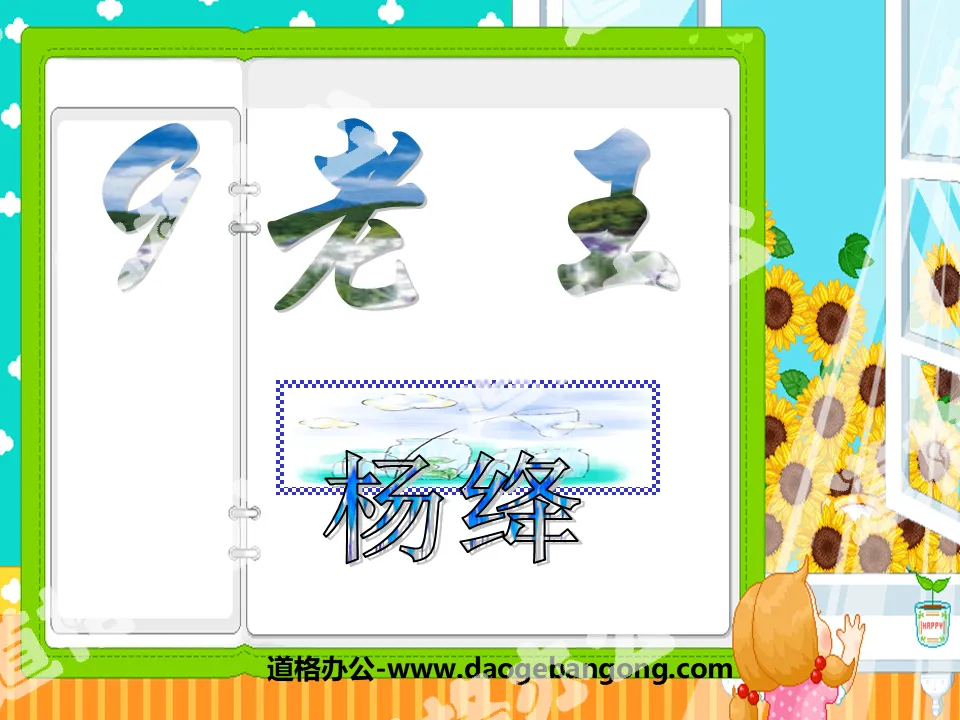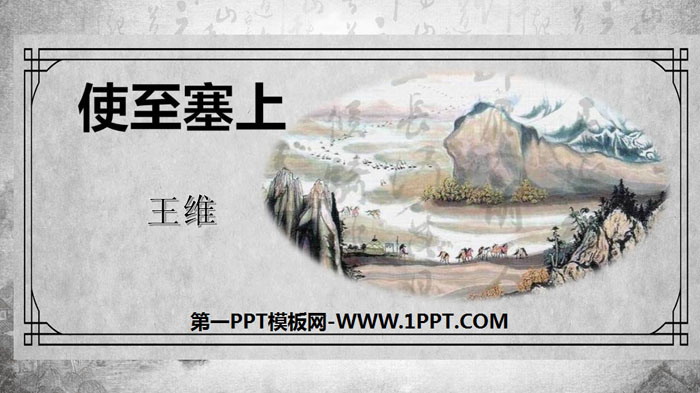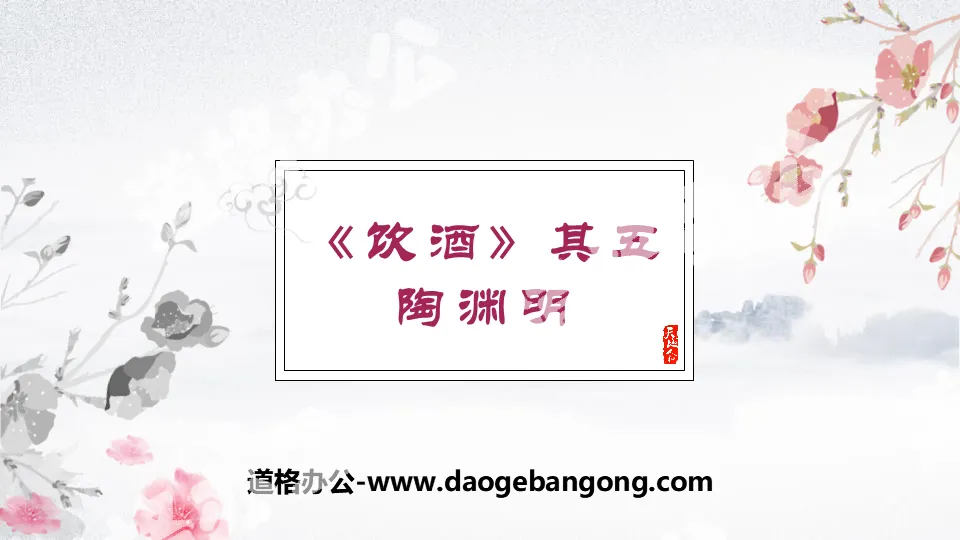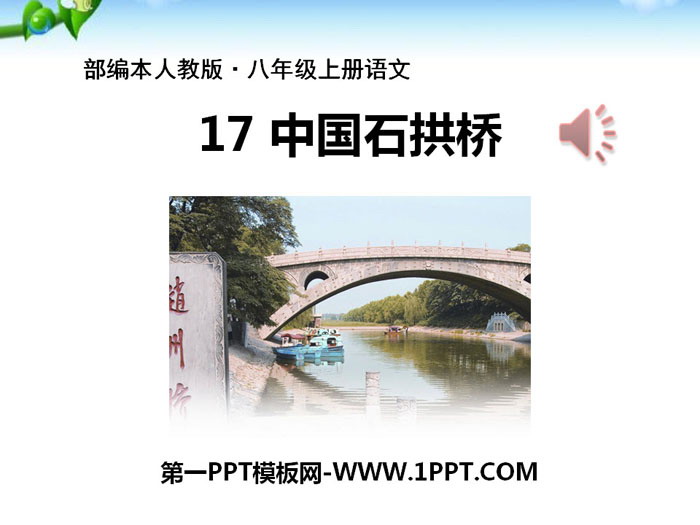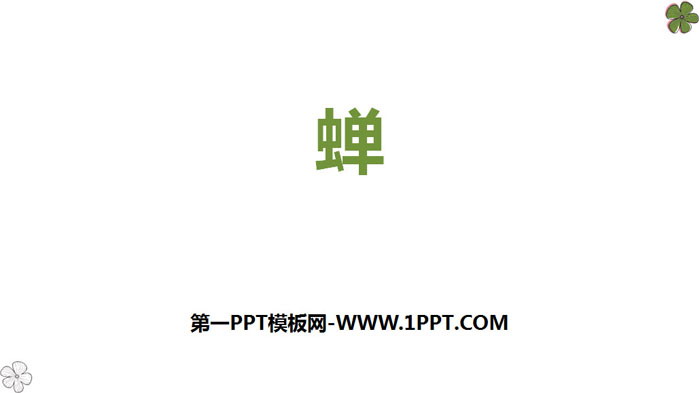
| Category | Format | Size |
|---|---|---|
| The first volume of Chinese language for eighth grade compiled by the People's Education Publishing House | pptx | 6 MB |
Description
"Cicada" PPT free courseware
Part 1: Importing new lessons
Introduction to ancient poetry: Show the verses of the ancient poem "Cicada".
Teacher: Today I brought you a riddle. However, this riddle is a bit difficult. It is a poem. Please read it yourself first and guess what this poem is about?
Hanging down to drink the clear dew, the sound of flowing water flows out of the sparse tung trees. The reason for speaking loudly and staying far away is not to borrow the autumn wind. Students read to themselves and guess names. --cicada
Teacher: Does anyone know whose poem this is? (Yu Shinan) Let us read this poem emotionally and read ancient poems together.
Teacher: There is a famous entomologist in the world who also wrote an article about "Cicada". Let us get to know him first.
Cicada PPT, part 2: Introduction to the author
Fabre (1823-1915) was a famous French entomologist and writer. He was the first scientist to study insects in their natural environment. He spent his entire life exploring the world of insects, observing and experimenting on insects in their natural environment, and truly recording the instincts and habits of insects. He wrote the entomology masterpiece "The Insect World".
Fabre was born in a farming family in the village of Saint-Leon in southern France. He spent his childhood in the countryside with flowers, plants, insects and birds. Due to poverty, he could not even finish middle school normally, but he insisted on self-study and obtained a bachelor's degree in mathematics, a bachelor's degree in natural science and a doctorate in natural science in his life. In 1880, he finally had a laboratory - a barren but fertile land loved by cornflowers and hymenoptera insects, which he humorously called "Barren Rock Garden". For the remaining 35 years of his life, Fabre continued to live in the "Barren Stone Garden". While conducting observations and experiments, he also compiled observation notes, experimental records, scientific notes and other materials he had studied insects in the first half of his life, and completed the book "Insect Diary". works. In 1915, the 92-year-old Fabre slept quietly in the "Barren Stone Garden" accompanied by his favorite insects. He is known as the "Virgil of the insect world" by his countrymen. The text "Cicada" is adapted from "Insect Diary". Fabre not only achieved himself through his own efforts, but also left us a very valuable wealth of knowledge.
Cicada PPT, the third part of the content: cultural and sports knowledge
Science essays, also known as knowledge essays, are an explanatory style that expresses scientific content vividly and vividly using the style of essays, using certain literary writing techniques. Often use some explanation methods, such as listing numbers, defining definitions, making metaphors, giving examples, making comparisons, etc. Science essays are generally short, concise, easy to understand, colorful in language, and lively in form. Reading this type of article can activate your thinking, enrich your knowledge, and broaden your horizons, and is very popular among readers.
Cicada PPT, Part 4: Overall Perception
1. In what aspects did Fabre introduce us to cicadas?
Clearly: two aspects - the cicada's burrow and the cicada's eggs. The full text is naturally divided into two parts. The first part, "Cicada's Crypt," introduces the growth process of cicadas from larvae to adults. Although the subtitle of this part is "Cicada's Crypt", the content is not just an introduction to the Cicada's Crypt, but simply means that the investigation of Cicada starts from the Crypt. This part can be divided into three levels.
The first level (paragraph 1): Show that you “have a good environment to study the habits of cicadas”, and introduce the seasons for studying cicadas and the situation of cicadas in your own living environment.
The second level (paragraphs 2 to 7): Write about the investigation of the cicada’s burrow. At this level, the investigation of the cicada's burrow is carried out in the order of observation from outside to inside. Paragraphs 2 to 3 describe the investigation of the external conditions of the crypt, and paragraphs 4 to 6 describe the investigation of the internal conditions of the crypt.
The third level (paragraphs 7 to 11): Write an investigation of the molting of cicada larvae. At this level, the investigation of larval molting is carried out in the order of development. Paragraph 7 describes the observation of the cicada's larvae first appearing on the ground. Paragraphs 8 to 10 describe the observation of the molting of the larvae. Paragraph 11 describes the observation of the cicada that has just shed its shell.
The second part, "Cicada's Eggs," introduces the growth process of cicadas from egg laying to larvae. Although the subtitle of this part is "Cicada's Eggs", the content does not only introduce the situation of cicada eggs, but means that the investigation of cicada's egg laying, hatching and adults begins with the introduction of egg laying. The explanation order of this part is the same as that of "Cicada's Crypt", and it is also explained according to the process of observing things. This part can be divided into four levels.
The first level (paragraphs 12 to 13): Introduces cicada egg laying, explaining the place, method and quantity of egg laying.
The second level (paragraphs 14 to 17) describes the dangers encountered by cicada eggs. First, it is explained that the reason for laying a large number of eggs is to have survivors when they are destroyed, and then the destruction of cicada eggs by gnats and the ignorance of cicadas are introduced.
The third level (paragraphs 18 to 24) introduces the hatching of cicada eggs and the activities of larvae. This level describes in detail the process of cicada larvae from molting, hanging, landing, and hiding underground.
Paragraph 24 says that after the larvae got into the burrow, it "hid itself and never appeared again." From now on, the cicada would not be discovered until four years later. That is the "first appearance of the cicada" written at the beginning of the second paragraph of the text. ". Only then will cicadas enter people's sight again. In this way, the text connects and integrates the growth process of cicada from egg to larva to adult.
The fourth level (paragraphs 25 to 26) summarizes the cicada's life: "Four years of hard work in the darkness, one month of enjoyment under the sun, this is the cicada's life." This not only corresponds to the introduction of the cicada's burrow, but also ends the explanation of the growth process of cicada eggs, and also provides a visual summary of the full text.
Cicada PPT, Part 5: Problem Exploration
1. Please read the article carefully about the cicada’s digging, shelling, laying eggs, larvae drilling into the soil and other details, outline the process, and see what characteristics the author grasped to introduce it? Then discuss and summarize together.
Clarification: Digging (paragraph 4): secreting mucus to turn the soil into mud and fixing the tunnel; shelling (paragraphs 7 to 9): finding a support point, the outer layer of skin splits from the back, performing strange gymnastics; giving birth Eggs (paragraphs 11 to 12): Select the smallest upward-turned branches and prick thirty or forty small holes on the dead branches; larvae burrow into the soil (paragraphs 23 to 24): Look for soft soil everywhere and use the foreleg's The hook digs into the ground, throws the soil out of the ground, digs the hole in the earth, burrows into it, and hides itself.
2. So in what order does our article describe the cicada's escape from its shell? Read paragraphs 8 to 10 of the text again.
Be clear: first find the supporting point - then write the changes in the back - then write the head, straw, front paws, wings and hind paws in sequence - and finally write the tail.
3. So what did you experience from these changes in the cicada’s shelling?
Clarity: The author observes carefully and seriously.
4. From the above analysis, it can be found that the author does not introduce the general growth process of insects in the order of "egg-larva-adult", but starts with the "larva" in the middle to introduce the cyclical life of cicadas. History (book on the blackboard), why did the author arrange the materials in this way?
Be clear: This arrangement is the author’s ingenuity. One: the larvae build burrows, which is much more vivid, rich and interesting than the eggs laid by adults. Starting with this can easily arouse the reader's interest in reading, and then follow the author to further explore the mysteries of the world of cicadas; second: make the writing more interesting. It is novel, lively, and unconventional; thirdly, and most importantly, it highlights the important characteristic of the cicada's "four years of dark hard work" (the cicada's activities for most of its life).
5. Ask students to make a table about the growth process of cicadas from egg laying to adult.
Clear: Adults lay eggs - cicada eggs hatch - larvae come out of the shell - larvae fall on the ground - go underground to find a hiding place - larvae burrow into the ground - larvae climb out of the burrow - larvae climb up Shrub branches or grass blades - Transform into adults - Adults fly away from branches - Adults mate (lay eggs, die)
6. Why can the author explain so clearly the growth process of cicadas that we are blind to?
Clarity: This is because the author has made long-term and careful observations. Judging from the article, for example, a cicada has a life cycle of four years and sings in the sun for five weeks, which shows that the author's observation of cicadas is long-term and meticulous. The official author's rigorous and persevering scientific spirit and comprehensive, detailed and in-depth observation methods allowed him to master a large amount of first-hand information, so that he could write such a vivid and accurate article.
Cicada PPT, Part Six: Language Features
As an explanatory text, "Cicada" is a scientific sketch. The explanation of "cicada" in this article is neither a systematic and purely scientific explanation like that in general dictionaries and entomological works, nor is it expressed using literary methods like general scientific sketches.
"Cicada" is essentially scientific observation notes and investigation reports, and belongs to the category of scientific works. However, the author uses some literary language to comprehensively introduce the scientific data describing the object, so it has a certain literary color. Mainly manifested in the following aspects:
The first is to personify the cicada and give it human emotions and behaviors. For example, it describes the cicada laying eggs, which describes the hardships of the "poor mother" in giving birth to children, and also describes the abomination of the cicada's destruction of living creatures. The story about the development of a cicada from an egg shows the hardship of the four-year long journey that the cicada goes through. This gives the article a strong appeal, allowing readers to lament the growth of this little creature, and thus respond to the author's question of "What kind of cymbal sound can be loud enough to praise its hard-won moment of joy?" Argumentation and lyricism resonate.
The second is to use literary language expression. For example, metaphors are used to express scientific phenomena that are generally unknown in a concrete way, and "performing a strange gymnastics" is used to compare the cicada's shelling process. Another example is to describe the observed situation in accurate and vivid language, writing that the cicada "jumps in the air", "turns over so that its head hangs upside down, stretches its wrinkled wings outwards, spreads it with all its strength,... tries its best to turn it up, and uses The front claws hook its empty skin, and then the tail end comes out of the shell." The verb in it accurately and vividly describes the entire process of the cicada's shelling.
Cicada PPT, Part 7: Class Summary
The full text is based on the author's observation of cicadas throughout their lives, starting with the cicadas emerging from their burrows on the summer solstice, and ending with the cicadas entering their burrows in the cold weather. It uses examples, numbers, analogies, comparisons, and other explanation methods to illustrate the cicada's life. The introduction of the living habits of cicadas enables us to understand the growth process of cicadas. The language is accurate, vivid and full of interest.
Cicada PPT, Part 8: Homework
Write about an insect or animal. Requirement: Students can also observe and study carefully like Fabre, and then write articles.
Keywords: Free download of Chinese PPT courseware for the first volume of the eighth grade Chinese version of the People's Education Press, Cicada PPT download, .PPT format;
For more information about the "Cicada" PPT courseware, please click on the Cicada PPT tab.
Cicada chirping sound effects at night:
PPT background sound effect of cicada chirping at night. ..
"Cicada" PPT free download:
"Cicada" PPT free download content of the first part: Introducing the new lesson: Drinking the clear dew and sounding out of the sparse trees, the loud voice is far from borrowing the autumn wind. Cultural and sports knowledge: science sketches science sketches: also known as knowledge sketches, is a kind of use The style of the essay introduces a certain aspect of scientific knowledge.
"Cicada" PPT courseware (Lesson 2):
"Cicada" PPT courseware (Lesson 2) Part 1: End of text Read the last two paragraphs in unison and find a central sentence in these two paragraphs. Four years of hard work in the darkness, one month of enjoyment in the sunshine, this is the life of a cicada. The two parts of the article seem to be reversed...
File Info
Update Time: 2024-06-30
This template belongs to Chinese courseware The first volume of Chinese language for eighth grade compiled by the People's Education Publishing House industry PPT template
"Cicada" PPT free courseware Simple campus recruitment activity planning plan summary enterprise and institution recruitment publicity lecture PPT template is a general PPT template for business post competition provided by the manuscript PPT, simple campus recruitment activity planning plan summary enterprise and institution recruitment promotion Lecture PPT template, you can edit and modify the text and pictures in the source file by downloading the source file. If you want more exquisite business PPT templates, you can come to grid resource. Doug resource PPT, massive PPT template slide material download, we only make high-quality PPT templates!
Tips: If you open the template and feel that it is not suitable for all your needs, you can search for related content "Cicada" PPT free courseware is enough.
How to use the Windows system template
Directly decompress the file and use it with office or wps
How to use the Mac system template
Directly decompress the file and use it Office or wps can be used
Related reading
For more detailed PPT-related tutorials and font tutorials, you can view: Click to see
How to create a high-quality technological sense PPT? 4 ways to share the bottom of the box
Notice
Do not download in WeChat, Zhihu, QQ, built-in browsers, please use mobile browsers to download! If you are a mobile phone user, please download it on your computer!
1. The manuscript PPT is only for study and reference, please delete it 24 hours after downloading.
2. If the resource involves your legitimate rights and interests, delete it immediately.
3. Contact information: service@daogebangong.com
"Cicada" PPT free courseware, due to usage restrictions, it is only for personal study and reference use. For commercial use, please go to the relevant official website for authorization.
(Personal non-commercial use refers to the use of this font to complete the display of personal works, including but not limited to the design of personal papers, resumes, etc.)
Preview

